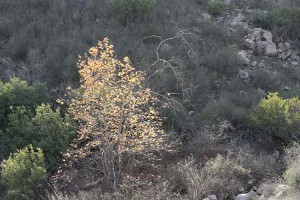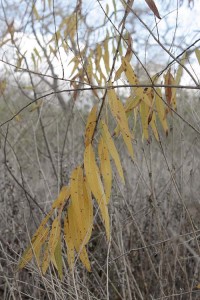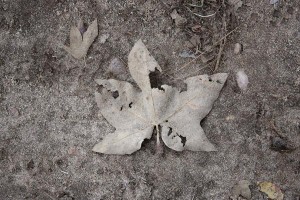
I first photographed these two trees over a decade ago, when I was working on a little photo project on local sycamores. I liked the way the two branches seemed to form a continuous arc when viewed from the right angle. Today, one of the trees is ailing and has lost some branches. Still, this little branch detail remains. The vegetation around the trees has changed over the years, as you might expect, and now you’ll have to stand in the middle of a big coyote bush brush to view the effect. At least it wasn’t a cactus.
When I started my photo series a lot of things attracted me to the Western sycamore, Platanus racemosa: their interesting branch structure, their over-scaled and dramatic leaves, their amazing exfoliating bark. And of the handful of native tree species within a few miles of my house, the sycamore may be the most spectacular this time of year. On my last trip to to San Diego’s Mission Trails Regional Park, I paid closest attention to what these trees were doing at the beginning of winter.

These are deciduous trees, along with the cottonwoods and willows, and they’ll attempt autumn or early winter color. Often the leaves are as much brown as they are yellow.

With a backdrop of gray sagebrush and black sage you’d never mistake this for a New England autumn postcard.

Things were nearing the end of leaf-fall. Most of the leaves lay underfoot.

Some of the leaves that weren’t underfoot were underwater.

With most of the leaves now off the trees, the light-colored bark stands out. Here a tree shows off its silhouette against a dark green evergreen live oak.

Looking closely at the bare trees lets you concentrate on their peeling bark. Who needs inkblots when you can do your own Rorschach test on patterns of sycamore bark? It’s great now, but will get more interesting as the year progresses.

Yellow, brown, gray and green are the main colors this time of year in the canyon bottoms where sycamores concentrate. Here’s a final shot of the last yellow-brown sycamore leaves of the season.

Nearby, cottonwoods contribute to the color scheme…

…as do the arroyo willows.
It won’t be long before the raucously colored flowers start up. But it’s a quietly beautiful time of year before they do.
























